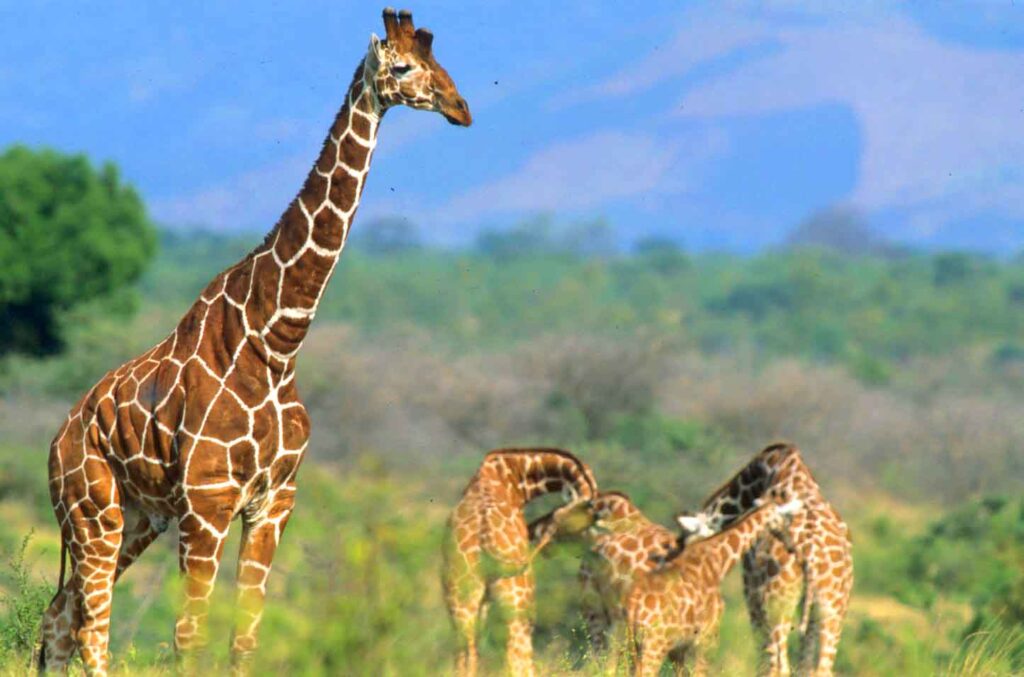Meru National Park, Kenya

“The Complete Wilderness”
Marvelous, remote, rugged and prominently unspoilt, Meru sits intact in a wilderness less visited, yet surrounded by undiluted natural beauty. It is wild and beautiful, straddling the equator and bisected by 13 rivers and numerous mountain-fed streams. The scenery is diverse from woodlands at 3,000ft on the slopes of Nyambene mountain range, northeast of Mt. Kenya to wide-open plains with meandering riverbanks dotted with doum palms.
The park teems with a variety of wildlife species including elephant, Grevy’s zebra, lion, cheetah, leopard, hartebeest, hippo, buffalo and the reticulated giraffe among others. Meru hosts a rhino sanctuary that is home to the endangered black and white rhino species. Critically endangered, the rhinos are under a twenty-four hour surveillance. The sanctuary offers one of the best rhino viewing experiences in the wild.
Bird life is also exceptionally diverse with over 400 bird species recorded. These include Peter’s Fin foot, inhabiting the Murera and Ura rivers; Pel’s fishing owl, kingfishers, rollers, bee-eaters, starlings and weavers. The rivers abound with hippo populations, crocodiles, and fish.
The park is famous as the setting for Joy Adamson’s book ‘Born Free”, the story of the Adamson’s life and research amongst lions and cheetahs. Elsa the lioness was the most well known and her grave is marked inside the park.
- Roads:
- Access from Nairobi (348 kms) is via Nyeri-Nanyuki-Meru or via Embu all weather roads. Access into the park from Maua to Murera Gate (35 km) and 348 km from Nairobi..
- The other access is via Embu to Ura Gate (120 km), 290 km from Nairobi
- Airstrip:
- Main airstrip at Kina, Mulika next to Meru Mulika Lodge and Elsa’s Kopje airstrip
- Former home of Joy and George Adamson and Elsa the lioness
- Views of Mt Kenya
- Rivers and riverine habitats
- Tana river
- Adamson’s falls
Privately Owned Lodges & Hotels
KWS Self Catering
Here are some frequently asked questions (FAQs) about Meru National Park:
Where is Meru National Park located?
- Meru National Park is located in the eastern part of Kenya, about 350 kilometers (217 miles) northeast of Nairobi, the capital city.
What is the main attraction of Meru National Park?
- Meru National Park is known for its diverse wildlife, including large herds of elephants, rhinos, buffaloes, lions, leopards, and various bird species. The park also features scenic landscapes, including rivers, forests, and grasslands.
How do I get to Meru National Park?
- Visitors can access Meru National Park by road from Nairobi, with the journey taking approximately 5 to 6 hours depending on traffic and road conditions. Domestic flights are also available to nearby airstrips, followed by a short drive to the park.
What activities can I do in Meru National Park?
- Visitors to Meru National Park can enjoy game drives, guided nature walks, birdwatching, and fishing in the park’s rivers and streams. Other activities include bush breakfasts, sundowner cocktails, and cultural visits to local communities.
Is it safe to visit Meru National Park?
- Yes, Meru National Park is considered safe for visitors. However, it’s essential to follow park regulations, stay on designated trails during walks, and be cautious of wildlife encounters.
When is the best time to visit Meru National Park?
- The best time to visit Meru National Park is during the dry season, from June to October, when wildlife congregates around water sources, making it easier to spot animals. However, the park can be visited year-round, and each season offers its unique experiences.
Can I see the Big Five in Meru National Park?
- Yes, Meru National Park is home to all members of the Big Five, including elephants, rhinos, buffaloes, lions, and leopards. Visitors have the opportunity to encounter these iconic African animals during game drives and safari experiences.
Are there accommodations available in Meru National Park?
- Yes, Meru National Park offers a range of accommodations, including luxury tented camps, lodges, and safari camps. Visitors can choose from various options to suit their preferences and budget, with many lodges offering guided safari activities and cultural experiences.
What wildlife can I see in Meru National Park?
- Meru National Park is home to a wide variety of wildlife, including large herds of elephants, rhinos, buffaloes, lions, leopards, giraffes, zebras, and numerous bird species. The park’s diverse habitats support a rich ecosystem of flora and fauna.
Are there dining facilities and amenities in Meru National Park?
- Yes, most accommodations in Meru National Park offer dining facilities, bars, swimming pools, and other amenities for guests’ comfort. Visitors can enjoy delicious cuisine and relaxation after a day of wildlife viewing and safari adventures.
